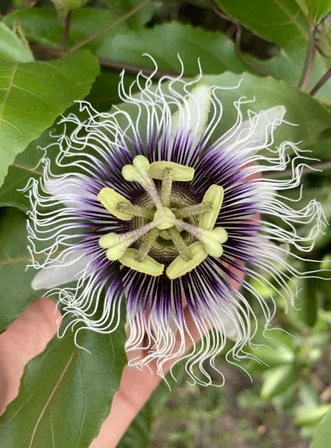Passion fruit – Passiflora edulis
Shipping calculated at checkout
Only 8 in stock
Need more? Contact us
Passion fruit is one of the world's most popular tropical fruits due to its intense aroma, sweet-tart taste, and varied culinary uses (juice, desserts, cocktails, etc.).
It comes from certain species of passionflower, climbing plants of the genus Passiflora—the same plants that produce the beautiful passionflower blossoms 🌺.
🍈Passion fruit – Passiflora edulis
🔎 Identification
- Scientific name: Passiflora edulis Sims
- Family: Passifloraceae
- Common names: Passion fruit, grenadilla, maracuja (in Portuguese/Brazilian)
- Origin: Tropical South America (Brazil, Paraguay, northern Argentina)
🌿Plant description
- Type: Perennial climbing plant with tendrils
- Stems: Thin, twining, easily wrapping around a support
- Height: up to 5–10 m depending on conditions
- Leaves: trilobed, shiny dark green
- Flowering:
- Spectacular 🌸 white and purple flowers, 6–8 cm in diameter
- Flowering from summer to fall in warm climates
- Very fragrant and attractive to insects
🍈Fruits
- Type: round or oval berry (4 to 8 cm)
- Skin:
- Thick and smooth at first, becoming wrinkled when ripe
- Purple (P. edulis f. edulis) or yellow (P. edulis f. flavicarpa) in color
- Flesh: Juicy, golden to orange, full of small edible black seeds
- Taste: Sweet, tart, very aromatic—a tropical concentrate! 😋
🌱Cultivation
- Exposure: full sun essential
- Soil: rich, humus-rich, well-drained
- Watering: regular in summer, without excess standing water
- Climate: tropical to subtropical (USDA zones 9–12)
- Hardy only to around 0°C (foliage destroyed at –2°C)
- Can be grown in pots in temperate climates → bring indoors in winter
🌸Pollination and fruiting
- Some varieties are self-fertile, others require cross-pollination
- Bees and bumblebees provide pollination
- Harvest: approximately 2 to 3 months after flowering, when the fruit falls or wrinkles naturally
🍹Culinary uses
- Eaten fresh with a spoon, or in juices, smoothies, cocktails, sorbets, pastries, sauces, etc.
- Mixed with mango, pineapple, or red berries
- Strong aroma → often used in gastronomy and perfumery
💊Nutritional values and benefits
- Rich in: vitamins A, C, fiber, potassium, antioxidants
- Low in calories (~90 kcal/100 g)
- Benefits:
- Boosts immunity
- Aids digestion
- Mild calming effect (linked to the plant's alkaloids)
✅Advantages
- 🌸 Splendid flowering
- 🍈 Delicious, vitamin-rich fruit
- 🐝 Honey plant and pollinator
- 🪴 Can be grown in pots in a greenhouse or conservatory
❌Things to watch out for
- 🌡️ Not very hardy (needs protection from frost)
- 🌿 Needs solid support
- 🦠 Susceptible to aphids, mites, and scale insects
- 🌸 Sometimes requires manual pollination in a greenhouse


